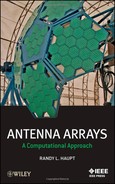PREFACE
This book is intended to be a tutorial on antenna arrays. Each chapter builds upon the previous chapter and progressively addresses more difficult subject material. The many pictures and examples introduce the reader to practical applications.
The book starts with some electromagnetics/antennas/antenna systems information that is relevant to the other eight chapters. The next two chapters deal with the analysis and synthesis of arrays of point sources and their associated array factors. These chapters would be useful for acoustic sensors as well as electromagnetic sensors. Chapter 4 presents a sampling of different kinds of elements that replace the point sources of the previous two chapters. The next chapter shows that the elements do not have to lie along a line or in a plane. Antenna elements may lie conformal to a surface or be distributed in space. Chapter 6 introduces mutual coupling where the elements radiate and receive electromagnetic waves, so they interact. These interactions are extremely complex and difficult to predict. Computer modeling and experiments are needed to predict the performance of arrays where mutual coupling is important. Chapter 7 introduces many different approaches to getting signals to and from the array elements to a computer where the signal detection takes place. Finally, the various numerical techniques behind smart antennas are introduced in Chapter 8.
This book emphasizes the computational methods used in the design and analysis of array antennas. I generated most of the plots presented in this book using one of three commercial software packages. MATLAB (MATLAB Version 2009a, The Math Works, www.mathworks.com, 2009) is the primary program used to do the plotting and calculations. MATLAB was also used to do many of the computations and is even useful for controlling experimental hardware. I used FEKO (FEKO, Suite 5.4, EM Software and Systems, www.feko.info, 2008) and CST Microwave Studio (CST Microwave Studio, Version 2009.7, Sonnet Software, Inc., www.sonnetsoftware.com, June 16, 2009) to generate the figures listed in the table below. The support staff at FEKO (C. J. Reddy, Ray Sun, and Rohit Sammeta) and Sonnet (Jim Willhite) were very helpful and responsive to my questions while writing this book.
I am grateful for the help I received from many different people. I am especially indebted for the extraordinary help from Northrop Grumman (Dennis Lowes and Dennis Fortner), the National Electronics Museum (Ralph Strong and Michael Simons), and Ball Aerospace (Peter Moosbrugger and Debbie Quintana). The numerous pictures they provided are credited throughout this book. I especially encourage you to visit the National Electronics Museum. It is free, and they have a tremendous collection of antennas as well as other interesting science/engineering items (children-friendly too). Boris Tomasic of the USAF AFRL enlightened me on some very interesting array work and provided me with a lot of pictures and information. Robert Horner and Hale Simonds of USN SPAWAR provided pictures and data on their interesting Vivaldi direction finding array. Junwei Dong and Amir Zaghloul of Virginia Tech gave me many pictures of their horn array and 360° Rotman lens. Régis Guinvarc’h (Supelec-Sondra) provided numerous pictures on several of his innovative research projects. Sue Ellen Haupt, Dan Aten, and Kris Greenert made some editorial comments on the manuscript. Finally, the following people gave me pictures to use in this book: Nick Deplitch (ARA Inc./Seavey Engineering), Roopa Bhide (Raytheon, Corp.), Patricia Smiley (NRAO), Lisa Bell (SKA Program Development Office), Micah Gregory and Doug Werner (Penn State), William Garnier (ALMA), Erik Lier (Lockheed Martin, Corp.), John Maciel (Radant Technologies, Inc.), Dan Schaubert (University of Massachusetts), Jamie M. Knapil and Steve Fast (Remcom, Inc.), and Andrea Massa and Paolo Rocca (University of Trento).
Some of the software that was used in this book is available at ftp://ftp.wiley.com/public/sci_tech_med/antenna_arrays.
Pennsylvania State University RANDY L. HAUPT

